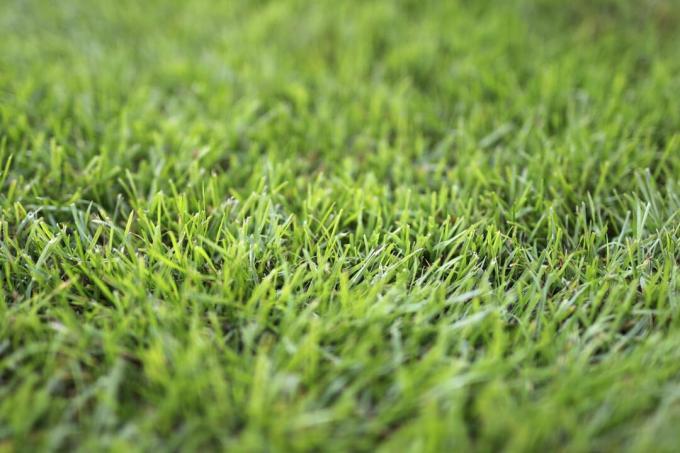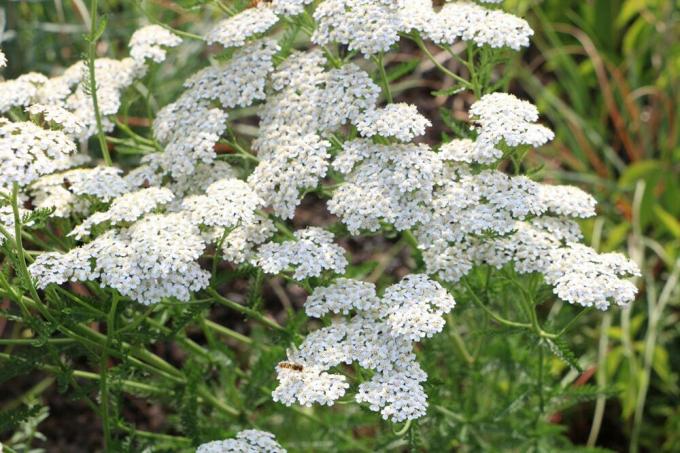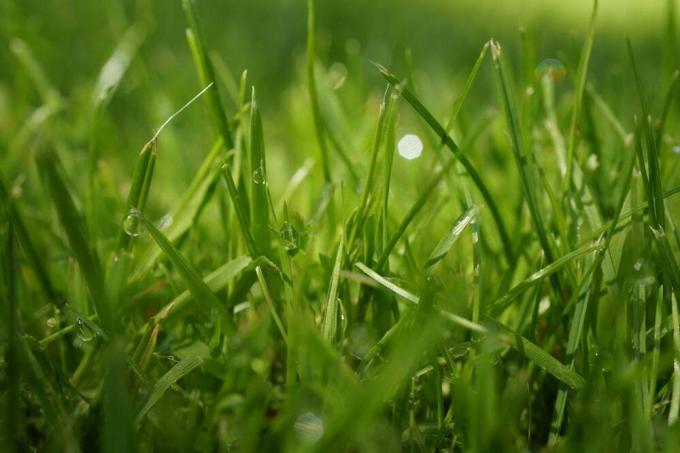

Table of contents
- Recognize
- Fight
- Tear out or not?
- clearing the garden bed
- Mow regularly
- plant potatoes
- Cover garden bed
- settle plants
- Fighting on lawn
- use of herbicides
- Prevent
Fallow land in particular is quickly colonized by creeping couch grass, a stubborn root weed in local gardens. It is important to fight the plants, for this there are different techniques and tips that are explained in the article.
Recognize
When the creeping couch grass (Elymus repens) spread in the garden, these should be identified as soon as possible so that they do not spread further underground. Due to the meter-long rhizomes that the weeds quickly develop, it can become very difficult to control the plants after a short time. But the weeds can also spread via the seeds that are blown into the environment by the wind. The wild grass can be recognized by various characteristics:
- upright growing culms
- are between 50 and 150 centimeters high
- grow in clumps
- spikes of flowers in two rows from June to August
- Leaves are similar to grass
- blue frosted or colored green
- Rhizomes grow horizontally just below the soil surface
- Root strands grow up to 80 centimeters deep
- Rhizomes are white or light-colored

Fight
There are various suitable methods to get rid of the couch grass in your own garden. The area over which the root weed spreads depends on this. Because both planted garden beds, a lawn or a fallow area can quickly become overgrown. But not every control measure is suitable, for example, for a planted bed or meadow.
Tear out or not?
When the gardener discovers weeds in his garden bed or on the lawn, the first thought is usually to simply rip them out. However, the question arises as to whether this is possible or even useful for root weeds:
- not just tear out
- not superficially chop off either
- makes no sense
- only the visible part is removed
- Rhizomes continue to grow underground
- new culms are quickly formed again
A notice:
It is often difficult to get rid of couch grass, especially on a densely overgrown bed or lawn remove, since simply tearing it out does not offer a good way to permanently close the root weed removed.
clearing the garden bed
It is easier if a fallow garden bed has been infested by the weeds. Because here you don't have to pay attention to any cultivated plants when fighting. Nevertheless, it is important to work very carefully here as well, so that all foothills of the roots in the bed are removed:
- unplanted sandy soil ideal for clearing
- Roots can be removed more easily
- if the soil is loamy, foothills could tear apart
- work with a fork
- carefully dig out all the roots
- be sure to include all horizontal roots
- then pull the long roots out of the ground
- leave the bed fallow for a long time after clearing
- Always remove newly emerging weeds
The garden bed should not be chopped or worked with a tiller. Although this destroys the rhizomes in the short term, most of the time residues of the roots remain in the soil.
Tip:
Even the smallest part of a rhizome left in the ground can cause weeds to spread across the bed again.
Mow regularly

If a fallow garden bed has been cleared, weeds can still grow again due to individual root pieces remaining in the ground. It can also help to mow the area regularly. This is for the following reasons:
- Couch grass should not bloom
- then seeds are formed
- these are scattered by the wind
- Weeds spread even further through sowing
- the weeds can be starved out by mowing
A notice:
Once you have removed the roots from the bed, they must not end up on the compost. Because here the weeds spread again unhindered. Disposal should always be done well sealed in the residual waste.
plant potatoes
If a fallow area in the garden has been cleared, it can be helpful to create a potato patch here:
- Potatoes grow tight
- form large leaves
- Bed is shaded
- In this way, couch grass can be prevented from growing again
- Weeds need a lot of sun to thrive
Cover garden bed
After spotting couch grass on a fallow bed, there are other ways to deal with it. Since weeds need air and light to grow, a cover is also a good way to successfully control them:
- in spring before budding
- Mow off all sprouting stalks beforehand
- then lay out corrugated cardboard
- over the entire bed
- Corrugated cardboard will rot by itself after 12 months
- alternatively work with opaque thick film
- Lay out a thin layer of mulch or soil on foil or cardboard
- cover at least 12 months
- suffocate roots
Tip:
If the bed is to be used again after the 12 months, it is important to fertilize here, for example by adding compost here. Because the corrugated cardboard used in particular removes a lot of nutrients from the soil.
settle plants
There are various plants that, in addition to potatoes, also deprive the weeds of light when they grow on the bed. In addition, other plants are offered nutrients in the soil to strengthen themselves by so-called green manure:
- Bergenia (Bergenia cordifolia)
- ivy (Hedera)
- evergreen honeysuckle (Lonicera acuminata)
- Nasturtium (Tropaeolum peregrinum L.)
- canola (Brassica napus)
- marigolds (calendula)
- Jerusalem Artichoke (Helianthus tuberosus)
- winter vetch (Vicia villosa)
It is important that the plants are sown or planted very densely so that the entire soil surface is covered with shade and the light is completely deprived of the root weeds.
Tip:
Tagetes do not deprive couch grass of light. They have a different property and can therefore be cultivated around the garden bed with the weeds. Because the weeds cannot tolerate the excretions of the marigold roots.
Fighting on lawn
If the couch grass appears on a lawn, then there are two possibilities here. If it is a meadow in which other herbs, flowers and other things also grow, then fighting is actually not necessary here. Because the root weeds do not damage the lawn. It only makes sense here to mow regularly so that the weeds do not multiply through the seeds in the rest of the garden. In the case of a well-tended lawn, on the other hand, the following procedure should be followed after recognition:
- Scoop out areas of couch potato growth (use a spade)
- flatly remove overgrown sods
- Carefully pull out rhizomes and above-ground parts by hand
- then work the deeper soil layers with the digging fork
- remove all rhizomes
- Level the ground again afterwards
- press with your foot
- then put the freed sod back on

Tip:
Even if this sounds like a lot of work to you at first, it's usually not that bad. Because the couch grass usually only occurs in a small area on a lawn and can therefore be fought well here.
use of herbicides
Of course, it is always possible to fight couch grass in the garden with chemical agents after recognizing it. However, this makes little sense. Because especially on overgrown areas, the plants cultivated here are also affected and damaged by the herbicides used.
Prevent
There are various preventive measures to prevent couchgrass infestation in your own garden in the first place. Because it is very difficult to control weeds on a bed or lawn that has already been cultivated:
- Do not undermine weeds when preparing the bed
- Avoid over-fertilization with nitrogen
- Mow the lawn regularly
- regular maintenance of all surfaces
- Strengthening of cultivated plants by watering and fertilizing
- Do not let couch grass flower
- lay a layer of mulch around cultivated plants on beds
- less light and air for couch grass roots in the soil
A notice:
You must be careful when using cattle or horse manure. Because this can contain the seeds of couch grass, which were previously ingested by the animals through food.
 garden editorial
garden editorial I write about everything that interests me in my garden.
Learn more about lawn care

Sanding the lawn: how much sand per m²?
The lawn is the focal point of the garden. Sanding the lawn can effectively influence its appearance. However, there are a few things to consider, because too much of it can also damage the green. Read here how much sand you should apply per m² when sanding the lawn.

Overseed the lawn without scarifying?
Which hobby gardener doesn't dream of a dense, lush green lawn? Bald spots not only look unsightly, they also encourage weed growth. But can you overseed a lawn without scarifying it first?

Iron fertilizer: the right use in the lawn
Iron fertilizer supplies the lawn and works against moss. However, it has to be used correctly. Therefore, observe the following tips to achieve optimal results for the grass plants and to avoid damage to the meadow.

Does coffee grounds help against clover in the lawn?
Clover in the lawn is a nuisance that many garden owners struggle with. Lawns, which in some cases are interspersed with numerous nests, are often affected. As an alternative to chemical agents, many wonder whether coffee grounds are effective against weeds.

Yarrow in the lawn | How do I get rid of yarrow?
There is no question that yarrow is one of the best-known medicinal herbs. It helps against colds and is used for skin diseases and gynecological problems. On the manicured lawn, she is seen as a troublemaker. How do you get rid of them? Are there effective alternatives to the chemical club?

Which lawn fertilizer to use in spring? 9 tips for spring
The winter months mean stress for the lawn. In the spring he therefore has to recover from the cold season and recharge his batteries. The gift of a spring fertilizer is therefore essential. Here is which one is suitable and what else needs to be done.



